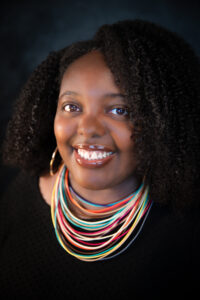
Associate editor Moriah Katz and author Remica Bingham-Risher discuss family, history, and the creative process behind Risher’s most recent poetry collection, Room Swept Home. Bingham-Risher’s poem, “Mary Taken to the Central Lunatic Asylum” is featured in volume 73.1. Read it here.
M: Who are you? Why do you write?
R: I think of myself primarily as a poet and a thinker. I write because it helps me articulate questions that I have about the world. It doesn’t give me all the answers, but it certainly helps me get a little bit closer to the things that I’m asking.
M: Would you say there’s a general theme to the questions you have?
R: Oh, it expands. Thank goodness! They say that poets only have a few subjects: childhood, God, love, dreams, and death. If you add in family and culture, I’m coming back to those [seven] themes. I’m asking many of the same questions over and over, but the questions get deeper over time.
M: As someone principally established as a poet, what has been your experience switching across forms, as well as seeing your work adapted into other mediums?
R: My second book, What We Ask of Flesh, has recently been adapted as a full scale dance production by INSPIRIT company director and choreographer Christal Brown. To see the work turn into that is unimaginable. It’s so expansive. There’s no way as a poet you ever imagined your words would morph in that many ways over time!
M: What does lineage mean to you? How do you balance paying homage to your elders’ voices while still honoring your own?
R: That’s a big question. I try to be in awe of them, but not so much that I am stifled into not moving at all. It’s a very fine, little teeny line.
M: Congratulations on the release of Room Swept Home! What was your process for writing this collection? Was it different than previous projects? If so, how?
R: The big difference was that I came to the page out of my interest in the way that these two women, my grandmother and great-great-great grandmother, intersected. I had to do so much more historical and ethnographic research than I had ever done before. I uncover[ed] history that is actually in my blood. That part of the process was really difficult and beautiful.
M: The cover for Room Swept Home is gorgeous. Are those family pictures on the front?
R: They aren’t. The reason that they’re not family pictures is because I have plenty of pictures of Mary, but no pictures of Minnie. I didn’t feel it was fair to put one of them on the cover and not the other.
M: How did the cover art come to be?
R: I’m always interested in hybridity and collage as an illumination of things. When I found Lisa Cain’s work, I loved what she was doing with painting and historical images. She let us create [the cover] together and painted a new piece from scratch in a matter of weeks for us to have in time for the book. Collaborating with her was a very fortunate part of the experience for me.
M: Minnie and Mary intersect in Petersburg, Virginia. Does your family have particular ties to this place?
R: Yeah, it’s so interesting. My paternal great-great-great grandmother, Minnie Fowlkes was born in 1859 in Petersburg, Virginia. She pretty much stayed there her entire life.
My maternal grandmother was originally from Scotland Neck, North Carolina, but was sent to the Central Lunatic Asylum for the Colored Insane in Petersburg, only a mile away from Minnie. They didn’t know each other or have any idea that the[ir] lineages would eventually cross.
M: How did you discover these two women lived in the same place at the same time?
R: I didn’t discover that for years and years. I’d heard whispers, particularly as my maternal grandmother got older. She was sent to [the Central Lunatic Asylum in Petersburg] for a little while after her first child was born. So I knew about Petersburg.
Now, [regarding] my paternal great-great-great grandmother, I got a call from my father’s mother. She had my aunt photocopy what she thought was a newspaper article about Minnie and send it to me.
I realized pretty quickly that the article was actually a transcript of a WPA slave narrativ, as I was familiar with these interview. I’d read many of them in the years prior. The subject’s name, the date of the interview, and the address appear at the top of the narrative. I found that same address still existed in Petersburg, Virginia. That’s what sent me down the historical rabbit hole!
M: In your interview with Ethelbert Miller, you mentioned being asked in a keynote address, “What identity of yours was more important? Your blackness, your womanhood, or your artistry?” Your answer was, “They all make me. What do you mean?”
How do you continue to honor all of your intersectionalities in an industry that endeavors to taxonomize and pigeonhole Black artists?
R: I just think that first question is ridiculous. I can’t separate [my identities from each other]. When I walk out into the world, I am all of those things. And I don’t want to separate them, because those complexities are what makes my life very interesting.
M: How does that praxis of fullness show up in Room Swept Home?
R: I wanted to illuminate [Mary and Minnie] in their fullest selves. For Minnie, I got to write about the fact that she was an entrepreneur, and a gardener, that she sold real estate. She had this community of women who cared for her. I got to write about women’s friendships – something we never get to really deal with enough – and how we bolster each other. There were all these different lines of her existence.
For Mary, I really got to flesh out who she was as a spiritual person. She was a sage advisor to her daughters, and the one [in the family] who really looked at what was happening in the face of history and had to find ways to let her faith counterbalance that [strife]. We don’t often get to talk about how people are able to move honestly in the most dire times.
M: Your poem “Mary Taken to the Central Lunatic Asylum” explores the moment that Mary Knight’s husband admits her to the psychiatric hospital. How do you make sense of that moment?
R: I knew Mary very well, we had lots of years together. Looking through that whole episode and having so much of it transcribed through the hospital records revealed that she was struggling. With [her family] she was the most quiet, docile person. But in [the hospital records], she was physically violent. It was like something broke in her. Really getting the context for that [shift] got me thinking about how my grandfather must have been shocked to see someone he loved turn into a different person. And then to come home and [have to tend to] a newborn child? These people are 18 and 20 years old [at the time]. It must have been the most frightening time in their lives. Reading it, I felt their residual fear and helplessness. It was hard to make my way through so much of that information. But it was wonderful to let her have a voice in that situation. Because she had a different one her entire life.
